Edward Prior
Further images
-
(View a larger image of thumbnail 1
)
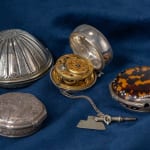
-
(View a larger image of thumbnail 2
)

-
(View a larger image of thumbnail 3
)
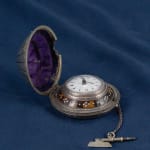
-
(View a larger image of thumbnail 4
)

-
(View a larger image of thumbnail 5
)
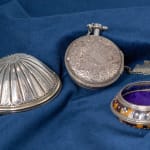
-
(View a larger image of thumbnail 6
)
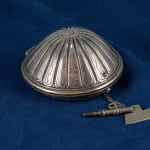
-
(View a larger image of thumbnail 7
)
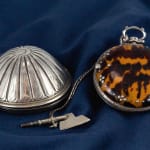
-
(View a larger image of thumbnail 8
)
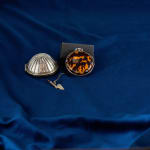
A very fine and imposing Victorian silver and tortoiseshell pocket watch, made for the Turkish Market, by Edward Prior of London, signed on the white enamel dial Edward Prior London and signed and numbered on the movement Edw Prior London 75601, and also featuring Edward Prior’s initials E.P., created from intertwined foliate scrolls issuing from a central urn that make up the pierced cock, the inner case hallmarked for the year 1864 and signed with the initials of the casemaker W.C.P. for the silversmith William Caleb Scott. The dial with black Turkish numerals showing the hours and an outer minute ring with five-minute divisions, with a pair of blued steel hands. The movement with a verge chain fusee escapement and ornate pierced pillars, with an outside count wheel and covered by an ornate foliate pierced cock. The watch with an inner silver case and then three further more ornate cases, the outer one of silver that encloses a silver studded tortoiseshell case and then a third case featuring musical instruments and engraved around the edge with flowers. The watch with its original axe-headed winding key
London, the case hallmarked 1864
Dimensions of the outer case 6.5 cm, dimensions of the watch itself 3.5 cm.
This beautiful pocket watch, made for the Turkish market, is typical of the quality of craftsmanship associated with the firm of Edward Prior of London, comparing closely with other fine examples, notable one in the Metropolitan Museum, New York. During a period of over a century, from 1765 up until 1878, George Prior (1735-1814), his son Edward Prior (1780-1859), Edward’s successor William Chambers (1797-1871), and then the latter’s son George, established themselves as leading clock and watchmakers, supplying the Ottoman market. Edward Prior was born on 25th December 1780 in Prescot Street, Aldgate, the London home of his parents George and Mary. On his father’s death in 1814, Edward succeeded the family business and continued to supply clocks to Turkey, and, like his father had acquired the Freedom of the Levant Company. In 1818 he moved the business from Prescott Street to South Street, Finsbury and then later to nearby Great Winchester Street. He was then joined by the watchmaker William Chambers, who by about 1849 was in partnership with Edward Prior and was working from 18 Powell Street East. Following William’s death in 1871, his son George Chambers took over the business until he declared bankruptcy in 1878.
The present clock was made after Edward had died and while William Chambers was heading the firm. Like many of that period bearing Edward Prior’s name, it is distinguished by certain features. Among the common characteristics that we can see here, such works made for the Ottoman market featured a white enamel dial with Turkish numerals. These watches often featured the ‘secret’ initials of Edward Prior as part of the decorative design within the finely pierced cock, while other common features include the movement’s raised pillars formed as foliage issuing from a vase-shaped column. Again, as here, the inner case was usually enclosed within three further cases, usually one made of horn or shell and two of silver. Multiple cases were not only decorative but also ensured that the clock’s movement was protected, especially from sand and dust that was often prevalent in Turkey and other hotter climates. The present set of cases were made by William Caleb Scott, whose initials appear on a number of others enclosing pocket watches signed Edward Prior. W. C. Scott was a London silversmith who was first recorded in 1856 at 22 Wynyatt Street, Goswell Road and then three years later was working nearby, at 70 Rahere Street.







